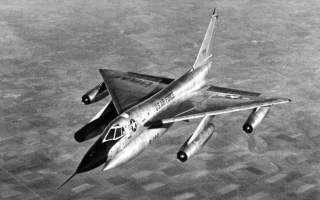Nuclear Bomber Fail: The B-58 Hustler Was a Beautiful Mistake
Why?
On Nov. 11, 1956, the first B-58 Hustler took flight. It would never see combat. An exotic, beautiful bomber designed for high-speed nuclear strike missions, a changes in Soviet tactics and a development method which dramatically hiked costs conspired to doom the Hustler — intended as a replacement for the jet-powered B-47 Stratojet.
Convair’s delta-wing Hustler was in some respects a fantastic aircraft, and as a supersonic jet bomber was capable of flying significantly faster — at Mach 2.0 — than the B-52 Stratofortress and the Stratojet. With a maximum altitude of 63,400 feet, it flew much higher than both of those bombers.
The Hustler was also small, for a bomber, with its 95.10-foot length and a 56.9-foot-wingspan. A B-52 is 64 feet longer and has 128 more feet of wing.
Speed was everything for the Hustler, as the Air Force aimed to have the bombers — armed with a single nine-megaton B53 nuclear bomb or four B43 or B61 nuclear bombs on four wing pylons — dash into the Soviet Union and China at speeds and altitudes that interceptors and surface-to-air missiles would have difficulty reaching.
In 1964, the CIA determined that the only Chinese aircraft possibly capable of intercepting it was the MiG-21 Fishbed and “even then” the chances of a successful hit would be “marginal.”
This was due in part to the Hustler’s four J79-GE-5A turbojet engines capable of individually producing 10,400 pounds of dry thrust. The delta wing shape also helped increase speed, but the resulting drag pushed the engineers to redesign the fuselage in a curved “coke-bottle” shape. A large bomb-and-fuel pod sat underneath the fuselage.
To reduce heat, Convair designed the B-58’s skin out of honeycombed fiberglass sandwiched between aluminum and steel plates, glued together instead of riveted. This engineering method would later inform future jet aircraft such as commercial airliners.
However, the Hustler’s small size created one of its biggest shortcomings for a jet designed to penetrate Soviet airspace — an unrefueled combat radius of only 1,740 miles. This would require the flying branch to base its Hustlers in Europe or devote substantial numbers of tankers for aerial refueling.
The short range was a serious concern in the Air Force, according to the 2012 book Rearming for the Cold War, 1945-1960 by retired USAF Col. Elliott V. Converse III.
Lt. Gen. Curtis LeMay of Strategic Air Command disliked the bomber and wanted the planes kept away from SAC. “In 1955, Maj. Gen. John P. McConnell, LeMay’s director of plans, commented wryly that as long as the Soviet Union and not Canada was the enemy, range would matter,” Converse wrote.
To make matters worse, the bomber was mechanically complicated, expensive — three times as much to operate than the B-52 — and difficult to develop. To redesign the fuselage into the “coke bottle” forced delays in the program and an increase in costs.
The number of planned B-58s changed — the Air Force would end up buying 116 Hustlers, a third of what the flying branch wanted. And because the bomber traveled so fast, the Air Force needed a new navigation and bombing system — the Sperry AN/ASQ-42 — which proved most troublesome of all to develop.
The J79 engine ran into problems, as did the braking system and ejection seats, the latter of which Convair ultimately swapped out for ejectable pods. “Despite the several speed records that it established, the B-58 may not have been worth its high cost,” Converse wrote.
More than anything else, two factors ultimately doomed the Hustler. The first was the development of better Soviet surface-to-air missiles in the 1950s culminating in the May 1960 shootdown of a high-flying U-2 spy plane piloted by Francis Gary Powers. The weapon, an S-75 Dvina — known by NATO as the SA-2 Guideline — could reach thousands of feet higher than the B-58’s maximum operating altitude.
One solution was to fly low, but flying low also means flying slow given the heavier air. Not only did that defeat the purpose of the Hustler’s design, the plane handled poorly at lower speeds. Twenty percent crashed.
The second problem was inherent to the U.S. Air Force’s demand that the B-58’s development occur concurrently, similar to the F-35 Joint Strike Fighter decades later.
“These central principles were that a system should be designed from the outset as an integrated whole and, based upon this plan, work on all of the elements making up the system, including its subsystems and aspects of its employment such as supporting facilities and equipment and training programs, should take place concurrently,” Converse wrote in Rearming for the Cold War.
Problems, when they arose, created cascading problems for the entire project. “When technological monkey wrenches showed up in the B-58 program, the system had to be redesigned or wait for the problems to be solved. As a result, development slowed, some production preparations had to be scrapped, costs rose, and deployment was delayed.”
If this sounds familiar, it should given the repeated delays to the F-35. While the Air Force promised that concurrency would reduce costs for the stealth fighter, it hasn’t. Quite the opposite.
The B-58 Hustler would never see combat and was never configured for non-nuclear bombing missions. In January 1970, the Air Force retired the aircraft. The flying branch’s nuclear-attack mission would fall to low-flying B-52s, B-1s, F-111s, stealthy B-2s and ballistic missiles — the latter of which were a testament to the success of concurrency.
The forgotten B-58’s failure, however, shrouded the reality of how dangerous concurrency can be in radically-new aircraft projects.
This first appeared in WarIsBoring here.

